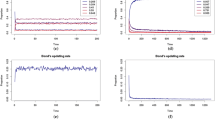Abstract
This article introduces new tools to study self-organisation in a family of simple cellular automata which contain some particle-like objects with good collision properties (coalescence) in their time evolution. We draw an initial configuration at random according to some initial shift-ergodic measure, and use the limit measure to describe the asymptotic behaviour of the automata. We first take a qualitative approach, i.e. we obtain information on the limit measure(s). We prove that only particles moving in one particular direction can persist asymptotically. This provides some previously unknown information on the limit measures of various deterministic and probabilistic cellular automata: 3 and 4-cyclic cellular automata [introduced by Fisch (J Theor Probab 3(2):311–338, 1990; Phys D 45(1–3):19–25, 1990)], one-sided captive cellular automata [introduced by Theyssier (Captive Cellular Automata, 2004)], the majority-traffic cellular automaton, a self stabilisation process towards a discrete line [introduced by Regnault and Rémila (in: Mathematical Foundations of Computer Science 2015—40th International Symposium, MFCS 2015, Milan, Italy, Proceedings, Part I, 2015)]. In a second time we restrict our study to a subclass, the gliders cellular automata. For this class we show quantitative results, consisting in the asymptotic law of some parameters: the entry times [generalising K ůrka et al. (in: Proceedings of AUTOMATA, 2011)], the density of particles and the rate of convergence to the limit measure.














Similar content being viewed by others
References
Belitsky, V., Ferrari, P.A.: Ballistic annihilation and deterministic surface growth. J. Stat. Phys. 80, 517–543 (1995)
Belitsky, V., Ferrari, P.A.: Invariant measures and convergence properties for cellular automaton 184 and related processes. J. Stat. Phys. 118(3–4), 589–623 (2005)
Boccara, N., Nasser, J., Roger, M.: Particle-like structures and their interactions in spatiotemporal patterns generated by one-dimensional deterministic cellular-automaton rules. Phys. Rev. A 44(2), 866–875 (1991)
Bušić, A., Fatès, N., Mairesse, J., Marcovici, I.: Density classification on infinite lattices and trees. Electron. J. Probab. 18, 22 (2013)
de Menibus, B.H.: Asymptotic behaviour of cellular automata: computation and randomness. Thèse présentée pour obtenir le grade universitaire de docteur (2014)
de Menibus, B.H., Sablik, M.: Developments in Language Theory. Self-organization in cellular automata: a particle-based approach, pp. 251–263. University of Milano-Bicocca, Milan (2011)
de Menibus, B.H., Sablik, M.: Entry times in automata with simple defect dynamics. In: Formenti E. (ed.) Proceedings 18th International Workshop on Cellular Automata and Discrete Complex Systems and 3rd International Symposium Journées Automates Cellulaires. Electronic Proceedings in Theoretical Computer Science, vol. 90, pp. 97–109. Open Publishing Association (2012)
de Menibus, B.H., Sablik, M.: Characterisation of sets of limit measures after iteration of a cellular automaton on an initial measure. arXiv:1301.1998, accepted to Ergodic Theory and Dynamical Systems (2013)
Delacourt, M.: Rice’s theorem for \(\mu \)-limit sets of cellular automata. In: Aceto L., Henzinger M., Sgall J. (eds.) Automata, Languages and Programming: 38th International Colloquium, ICALP 2011, Zurich, Switzerland, Proceedings, Part II, pp. 89–100. Springer, Berlin, 4–8 July 2011
Eloranta, K.: The dynamics of defect ensembles in one-dimensional cellular automata. J. Stat. Phys. 76, 1377–1398 (1994). doi:10.1007/BF02187067
Eloranta, K., Nummelin, E.: The kink of cellular automaton rule 18 performs a random walk. J. Stat. Phys. 69(5–6), 1131–1136 (1992)
Fatès, N.: Stochastic cellular automata solutions to the density classification problem. Theory Comput. Syst. 53(2), 223–242 (2013)
Fisch, R.: The one-dimensional cyclic cellular automaton: a system with deterministic dynamics that emulates an interacting particle system with stochastic dynamics. J. Theor. Probab. 3(2), 311–338 (1990)
Fisch, R.: Cyclic cellular automata and related processes. Phys. D 45(1–3), 19–25 (1990)
Grassberger, P.: New mechanism for deterministic diffusion. Phys. Rev. A 28, 3666–3667 (1983)
Grassberger, P.: Chaos and diffusion in deterministic cellular automata. Phys. D 10(1–2), 52–58 (1984)
Gray, L., Griffeath, D.: The ergodic theory of traffic jams. J. Stat. Phys. 105(3–4), 413–452 (2001)
Kůrka, P.: Cellular automata with vanishing particles. Fundam. Inf. 58(2003), 203–221 (2003)
Kůrka, P., Maass, A.: Limit sets of cellular automata associated to probability measures. J. Stat. Phys. 100(5–6), 1031–1047 (2000)
Kůrka, P., Formenti, E., Dennunzio, A.: Asymptotic distribution of entry times in a cellular automaton with annihilating particles. In: Proceedings of AUTOMATA, pp. 89–100 (2011)
Lind, D.A.: Applications of ergodic theory and sofic systems to cellular automata. Phys. D 10(1–2), 36–44 (1984)
Merlévède, F., Rio, E.: Strong approximations of partial sums under dependence conditions with applications to dynamical systems. Stoch. Process. Appl. 122, 386–417 (2012)
Mörters, P., Peres, Y.: Brownian Motion. Cambridge series in statistical and probabilistic mathematics. Cambridge University Press, Cambridge (2010)
Pivato, M.: Algebraic invariants for crystallographic defects in cellular automata. Ergodic Theory Dyn. Syst. 27(01), 199–240 (2007)
Pivato, M.: Defect particle kinematics in one-dimensional cellular automata. Theor. Comput. Sci. 377(1–3), 205–228 (2007)
Pivato, M.: Spectral domain boundaries in cellular automata. Fundam. Inf. 78(3), 417–447 (2007)
Redner, S.: A Guide to First-Passage Processes. Cambridge University Press, New York (2001)
Regnault, D., Rémila, E.: Lost in self-stabilization. In: Mathematical Foundations of Computer Science 2015—40th International Symposium, MFCS 2015, Milan, Italy, Proceedings, Part I, pp. 432–443, 24–28 August 2015
Stein W.A., et al.: Sage Mathematics Software (Version 4.2.1). The Sage Development Team (2012) http://www.sagemath.org
Theyssier, G.: Captive Cellular Automata. MFCS 2004, LNCS, vol. 3153, pp. 427–438 (2004)
von Neumann, J.: Probabilistic logics and the synthesis of reliable organisms from unreliable components. Autom. Stud. 34, 43–98 (1956)
Walters, P.: Graduate Texts in Mathematics. An introduction to ergodic theory, vol. 79. Springer, New York (1982)
Wolfram, S.: Universality and complexity in cellular automata. Phys. D 10(1), 1–35 (1984)
Zhengyan, L., Chuanrong, L.: Limit Theory for Mixing Dependent Random Variables, vol. 378. Springer, Berlin (1996)
Acknowledgements
This work was partially supported by the ANR Project QuasiCool (ANR-12-JS02-011-01). B. H. de Menibus acknowledges the financial support of Basal Project No. PFB-03 CMM, Universidad de Chile. We also thank two anonymous referees for their careful reading and many remarks.
Author information
Authors and Affiliations
Corresponding author
Rights and permissions
About this article
Cite this article
Hellouin de Menibus, B., Sablik, M. Self-organisation in Cellular Automata with Coalescent Particles: Qualitative and Quantitative Approaches. J Stat Phys 167, 1180–1220 (2017). https://doi.org/10.1007/s10955-017-1760-8
Received:
Accepted:
Published:
Issue Date:
DOI: https://doi.org/10.1007/s10955-017-1760-8



